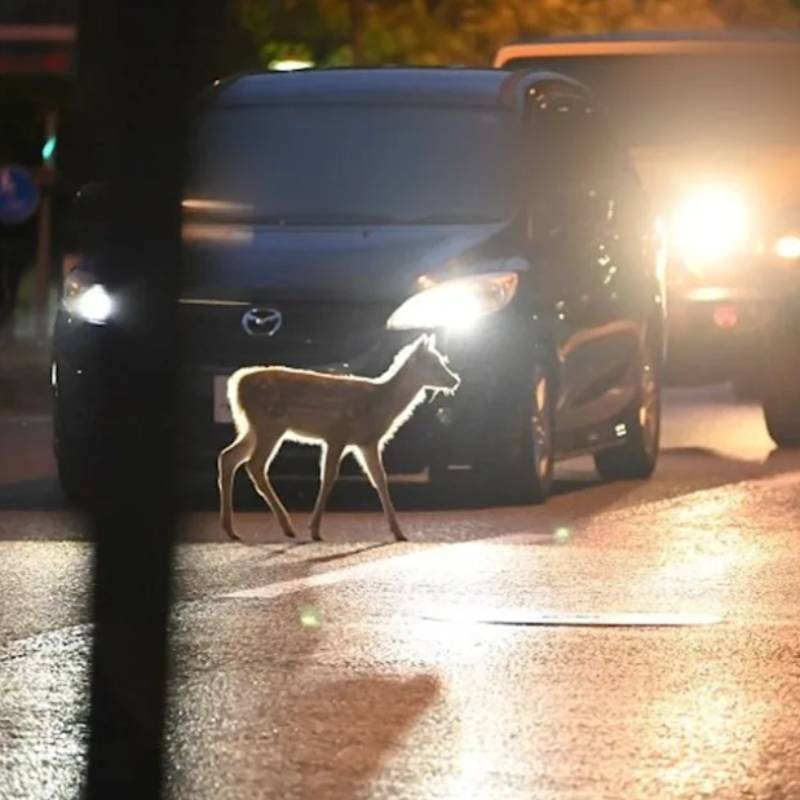Deer Collision? Your Ultimate Survival Guide
Deer collision? This guide SAVES you money & stress. Expert tips on what to do immediately, handling claims, and avoiding accidents. Read NOW!
One of the most frightening things while driving is when a deer suddenly darts out from the roadside.
Especially at night, when visibility is poor, there’s hardly any time to react.
Knowing what to do when a deer appears unexpectedly is crucial for avoiding accidents and damage.
This isn’t a rare event.
According to the latest data from State Farm, there are roughly 1 to 2 million vehicle collisions with deer each year in the United States.
(Source: State Farm, 2023)
The average repair cost per incident exceeds $5,000!
And that doesn’t include potential injuries.
Imagine this: it’s getting dark, and you’re driving on a rural road.
Suddenly, two glowing eyes appear in your headlights.
Your heart skips a beat.
What do you do next?
Should you swerve? Slam on the brakes? Or just hope for the best?
Don’t panic!
This article is your life-saving guide.
We’ll explain in plain language exactly what to do when you see or hit a deer.
We cover everything: how to react in the moment, how to handle insurance claims, and how to prevent these accidents.
Our goal is simple: to get you home safely.
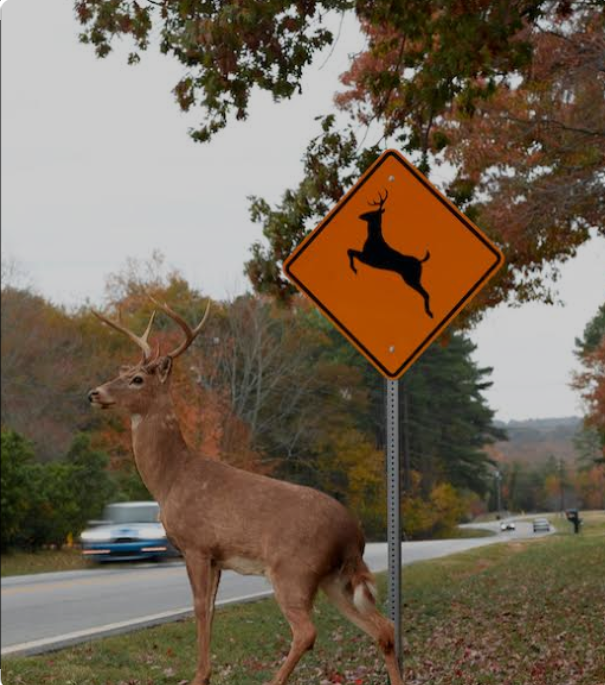
Part 1: Why Are Deer Such a Big Problem? Know Your “Opponent”
To solve a problem, you first need to understand it.
Deer aren’t trying to hit your car—they act in predictable ways.
Deer Behavior Patterns
First, deer are most active at dawn and dusk.
Coincidentally, these are also the times when drivers have the hardest time seeing.
The light is dim, and your eyes struggle to adjust, making it easy to miss movement on the roadside.
Second, fall (October to December) is deer mating season.
They become extremely active, running around without paying attention to traffic.
That’s why autumn is the peak season for deer-vehicle collisions.
Here’s another trap: deer rarely travel alone.
If you see one deer crossing the road, don’t relax just yet.
There’s a good chance a second or third deer is following close behind.
Many accidents happen when a driver avoids the first deer, lets their guard down, and then hits the next one.
High-Risk Areas
Deer tend to live near wooded areas, water sources, and farmland edges.
These places become high-risk zones for collisions.
If you often drive in these areas, stay especially alert.
You can also check local wildlife collision hotspot maps to see which roads have frequent deer activity.
This helps you stay prepared.
Serious Consequences of a Collision
Deer are not small animals.
An adult white-tailed deer can weigh up to 200 pounds (about 90 kilograms).
Hitting an animal that size at 60 miles per hour is devastating.
The impact can deploy your airbags, cause serious vehicle damage, or even make you lose control and roll over.
This poses a significant threat to the safety of the driver and passengers.
Then there’s the financial loss.
The average repair cost is over $5,000 per incident.
If you don’t handle the situation correctly, insurance claims can become complicated and costly.
Understanding these risks shows why prevention and the right reaction are so important.
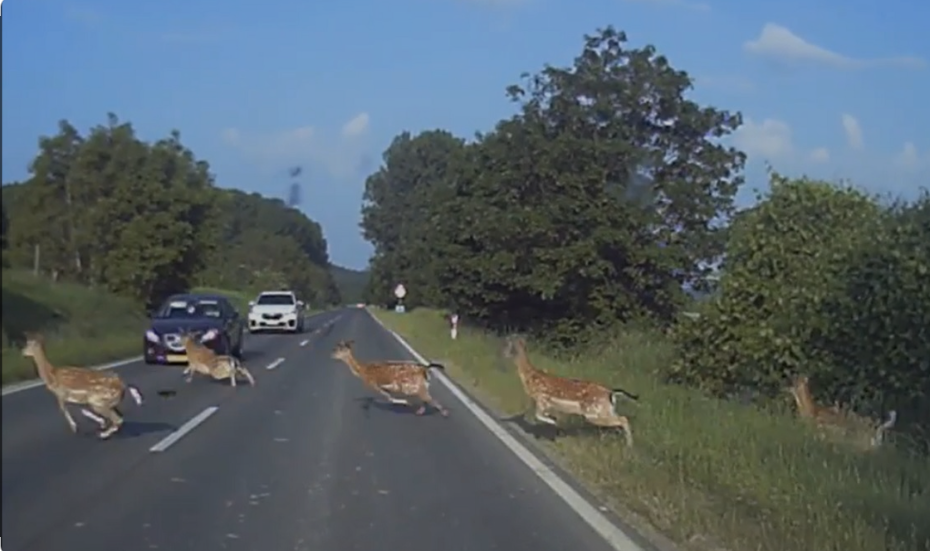
Part 2: How to Stay Safe in Critical Moments – A 3-Step Guide
Every second counts in an emergency.
Your decisions affect everyone in the vehicle.
Below, we break down what to do in three scenarios.
Scenario 1: You See a Deer on the Side of the Road or Ahead
If you see a deer with enough time to react, follow these steps:
- Stay calm and grip the steering wheel firmly.
This is the most important rule!
Panic is your worst enemy.
Keep both hands on the wheel to maintain control. - Slow down and turn on your high beams (if there’s no oncoming traffic).
Ease off the gas and brake steadily.
If it’s safe, switch to high beams.
They help you see farther, and the bright light can sometimes “freeze” the deer in place.
They also make the deer’s eyes reflect light like two small lightbulbs, making them easier to spot early. - Give a long honk with your horn.
The loud noise may scare the deer and make it stop or run away. - Be prepared for it to run into the road.
Don’t assume it will avoid you; mentally and physically prepare for the possibility that it might dart in front of your vehicle.
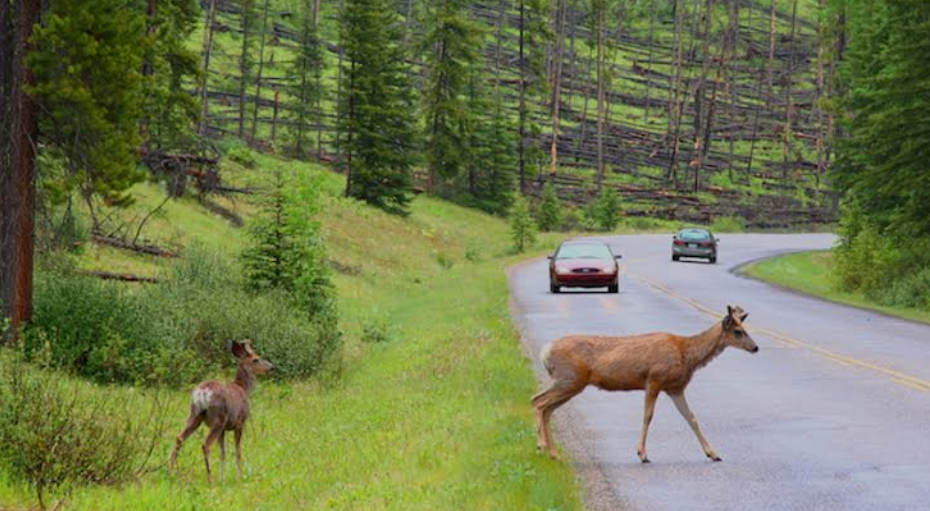
Scenario 2: A Collision Is Unavoidable
If a deer jumps out too close for you to stop safely, your choices matter.
- The right thing to do: Brake as hard as you can and hold the steering wheel straight.
Yes, you read that correctly.
In most cases, hitting the deer straight on is the least damaging option.
This is recommended by AAA and other safety organizations. (Source: AAA)
Why?
Because swerving can be extremely dangerous.
You might veer into oncoming traffic, hit a tree or a pole, or even roll over.
These types of accidents often cause more severe injuries than hitting a deer. - Only swerve if: You are 100% sure the next lane is completely empty, and you have enough space to move over safely.
But this is a split-second decision with high risk.
In most cases, braking and holding steady is safer.
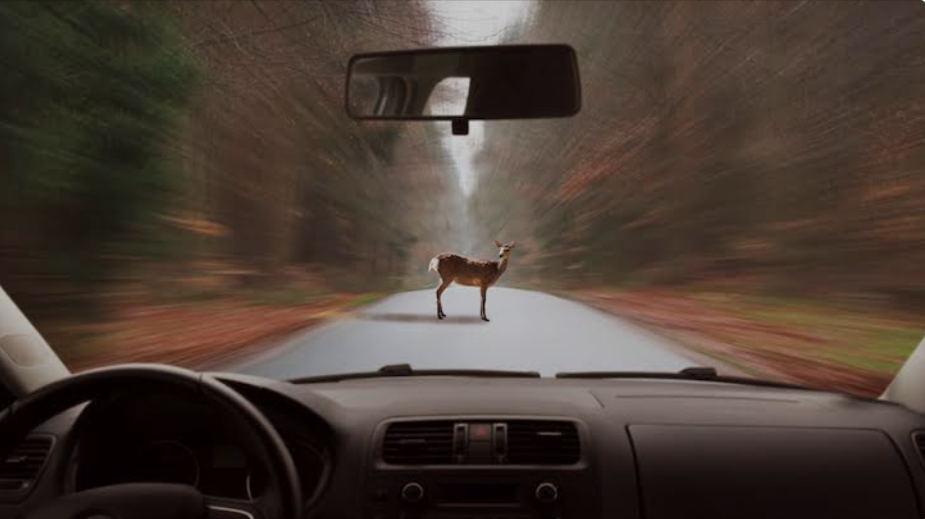
Scenario 3: You’ve Already Hit a Deer
If a collision happens, don’t freeze.
Follow these steps in order:
- Prioritize safety first.
Move your car to the side of the road if possible.
Turn on your hazard lights.
If the car won’t move, get everyone to a safe place away from traffic, like behind a guardrail. - Call 911 immediately.
Even if the deer ran away and the damage seems minor, it’s best to call the police.
Many states require you to report any wildlife collision that causes more than a certain amount of property damage (usually $1,000 or $1,500).
A police report is essential for your insurance claim. - Take photos for evidence.
If it’s safe, take pictures of the scene.
Include your vehicle’s damage, the deer’s location (but don’t approach), the road conditions, and your license plate.
These photos will serve as evidence. - Do not approach the deer!
An injured deer is scared and in pain—it can become aggressive.
Its hooves and antlers are dangerous.
Wait for the police or wildlife authorities to handle the situation. - Contact your insurance company.
Call your insurer as soon as possible to report the accident and start the claims process. - If the deer is killed, do not handle the body yourself.
Wait for the police, wildlife agency, or road maintenance crew to remove it.
Handling wild animal remains may be illegal, and professionals know how to prevent disease and environmental contamination.
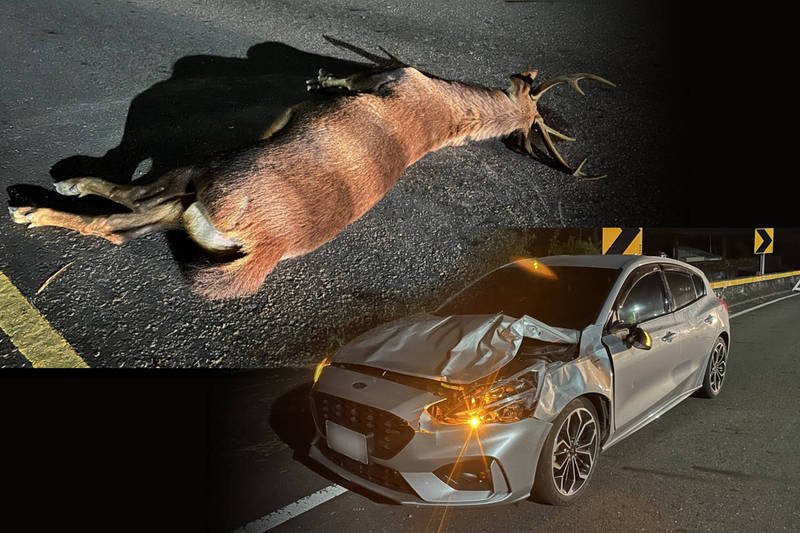
Part 3: How Does Insurance Work? Avoid Costly Mistakes
Deer collisions are tricky when it comes to insurance.
A wrong move could mean bearing the cost yourself.
Here’s a key point:
Deer collisions are usually not covered by collision insurance.
Instead, they fall under comprehensive coverage.
- Collision coverage: Pays for damage when your car hits another vehicle or object (like a guardrail or tree).
- Comprehensive coverage: Covers damage from “unexpected” events like falling trees, hail, vandalism, or hitting an animal.
So, make sure your insurance policy includes comprehensive coverage.
If you only have liability and collision insurance, you won’t be covered for deer-related repairs.
When you file a claim, you’ll need to pay your deductible.
This is the amount you agreed to pay out of pocket before insurance covers the rest.
For example, if your deductible is $500 and repairs cost $5,000, the insurance company will pay $4,500.
Deductibles vary by policy, so check your plan details.
Claims Process
Remember, the police report and photos are your best friends for a smooth claims process.
- Get a police report.
As mentioned earlier, this document is critical for your claim. - Contact your insurance company and submit evidence.
Provide photos, repair estimates, and any other relevant details.
This helps speed up the process. - Arrange for vehicle inspection and repairs.
Your insurer will send an adjuster to assess the damage.
You can choose a repair shop they recommend or one you trust—just make sure it’s reputable.
FAQ: Will My Insurance Rates Go Up After a Deer Claim?
In most cases, a comprehensive claim for hitting a deer is considered a “not-at-fault” incident and should not directly cause your premiums to increase. However, multiple claims within a short period could have an impact. Always check with your specific insurance provider.
Part 4: How to Prevent Deer Collisions: Upgrade Your Driving Safety
As the old saying goes, prevention is better than cure.
Besides staying alert, there are more effective ways to protect yourself.
Do Traditional Methods Work?
While these methods are helpful, they don’t solve the core problem: limited visibility in low-light conditions.
- Deer whistles: These devices attach to your car and claim to emit a high-frequency sound that scares deer away.
But independent tests show inconsistent and often unreliable results.
Wind speed, vehicle speed, and other factors affect their performance.
There’s little scientific proof they work consistently. - Staying Alert: Staying alert is always good advice.
Be extra cautious in areas with deer warning signs, near woods, and by water.
But human attention has limits.
Long drives can be tiring, and accidents often happen in a moment of distraction. - Standard headlights (even LED lights): Their effectiveness drops in rain, snow, fog, or when facing glare from oncoming traffic.
This shortens the time you have to spot animals and react.
How Technology Can Help: Thermal Imaging Expands Your Vision
Today, a technology once limited to military or luxury vehicles can help everyday drivers: thermal imaging.
Thermal cameras detect heat instead of relying on light.
That means they can clearly show the outline of people, animals, and vehicles even in total darkness, rain, fog, or glare.
Imagine if your device could detect a deer hiding in the woods hundreds of feet away, highlight it with a colored box on the screen, and give you an early warning.
You’d have plenty of time to slow down and react.
This changes the game from reactive to proactive. Instead of a split-second brake decision, you now have 5-10 seconds to calmly slow down and stop.
This technology is becoming more accessible and offers a powerful option for safety-conscious drivers.
It doesn’t replace your judgment—it enhances your awareness, especially in the most dangerous low-visibility conditions.
Choosing a Professional Thermal Imaging Device: Robofinity InsightDrive
Among various automotive safety devices, the Robofinity InsightDrive stands out with its professional AI-powered thermal imaging.
It significantly improves driving safety at night and in bad weather.
Its core advantage is AI recognition that accurately distinguishes between cars, people, and wildlife with up to 95% accuracy.
It marks potential hazards with color-coded boxes on the screen, making it easy to understand.
It can detect objects up to 656 feet (200 meters) away—far beyond the range of headlights—giving you valuable extra time to react.
The device is IP67 waterproof, so it works even in heavy rain or when washing your car.
With low power consumption (≤5W), it won’t drain your battery.
Best of all, it’s easy to install without complicated wiring—just plug it into your cigarette lighter and use the included mount.
You can set it up in under 5 minutes and enjoy a new level of safety.

Conclusion: Safety Is a Priceless Investment
In summary, if you encounter a deer while driving, stay calm and take the right steps.
- If you see a deer: Slow down, honk, use high beams if safe, grip the wheel, and stay aware.
- If a collision is unavoidable: Brake straight, hold the wheel steady, and avoid swerving.
- After a collision: Move to safety, turn on hazards, call the police, take photos, don’t touch the deer, and call your insurance.
- Insurance: Make sure you have comprehensive coverage.
Deer collisions can happen to anyone.
Learning these tips isn’t meant to scare you—it’s meant to make you more confident in an emergency.
Investing in safety always pays off.
Whether it’s reading this guide or considering advanced technology like thermal imaging, you’re protecting yourself and your family.
Don’t wait until after an accident to take action.
The Robofinity InsightDrive thermal imaging device offers 24/7 protection and helps you see clearly in any light or weather.
Invest in peace of mind today and drive with confidence on every night-time trip.
The knowledge in this guide is a crucial first step. But for true peace of mind on the road, consider a solution that offers a clear view of the unseen.

